News Archive
-
Nov 5 2019
The Stratospheric Report #02 - November 2019
Welcome back. Glad to see you here again. If this is your first time with the Report, you should read the first issue to see what the thing is about. Plenty of data sometimes means pretty boring. So you have been warned !.
On this edition we have a complete update on Project Loon including latest launches, landings and the current status of the balloon fleet; some interesting -and accidented- activity of their cousins of Raven Aerostar; news on the dismissed appeal on World View Enterprises lawsuit and mixed results on balloon flights; details of two balloon launches in Sweden with student payloads for BEXUS project; the Strateole 2 campaign starting in the Seychelles Islands; upcoming balloon-based tests for ExoMars parachutes in the United States and finally some interesting balloon-related publications.
Enjoy it !. See you in other 15 days !
-
Project Loon launches and landings and current status of the balloon fleet
Latest balloon launches performed by Project Loon
With the reactivation of the launch site of Project Loon in Puerto Rico in early October -once the hurricane season in the Atlantic was over- the facility is again in charge of the launch of what I call "operational flights", that is those balloons that are added to the project's worldwide fleet. On the other hand, the Winnemucca launch base in Nevada returned to its primary role of performing balloon flights for research and development or testing purposes, which are short lived missions which rarely abandon the Continental US territory.
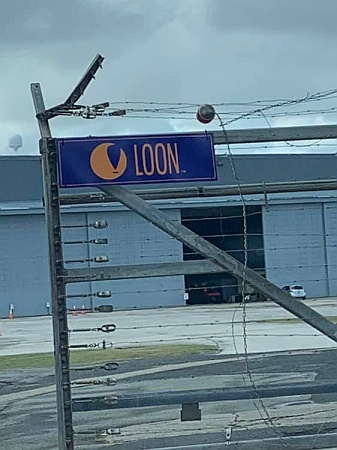
Below is a choronological resume of the last launches performed since the last issue of this report from both installations. In the case of flights from Winnemucca if no landing site is mentioned, it means that the flight ended in the state of Nevada.
First balloon up for this update was launched on October 20, 2019 at 17:18 utc from Winnemucca as HBAL051. It endured in flight 2 hours and 16 minutes, landing at 19:34 utc.
Two days later, on October 22 occured the major activity of the period with eight flights from both launch bases. During the night, three operational flights were sent aloft from Puerto Rico. HBAL039 at 00:57 utc, HBAL040 at 2:08 utc and HBAL038 at 3:12 utc. During the day, five balloons were launched from Winnemucca. The first one HBAL027 was the only one sent aloft from Nevada that day which turned out to be an operative flight. It was launched at 15:28 utc and after crossing the United States it was at the closing of this edition of the report flying in the Caribeean close to Republica Dominicana. The other four balloons launched from Winnemucca were short lived missions: with the exception of HBAL052 launched at 16:24 utc which endured three and a half hours, the rest of the missions barely reached two hours aloft. HBAL050 was launched at 19:25 utc with landing at 20:29 utc, HBAL053 with launch at 20:01 utc, landed 21:38 utc and finally HBAL054 which was launched at 21:10 utc, landed at 22:56 utc.
On October 25 two short duration missions were launched from Winnemucca HABL058 at 13:08 utc and HABL057 at 14:29 utc. Landings occured at 17:09 utc and 19:44 utc remaining aloft 4 and 5 hours respectively.
On October 26, five balloons were launched from Puerto Rico: HBAL034 at 2:00 utc, HBAL041 at 2:49 utc. HBAL043 at 3:45 utc, HBAL042 at 4:40 utc and finaly HBAL066 at 5:25 utc.
The next day a single balloon was launched from Nevada. The flight of HBAL056 started at 15:08 utc with landing at 18:44 utc after 3 hours and 36 minutes aloft.
Four more balloons were added to the fleet on October 30 from Puerto Rico: HBAL067 at 00:12 utc, HBAL069 at 2:40 utc. HBAL070 at 3:46 utc, and HBAL072 at 23:40 utc.
To close this chronicle, the latest two launches of October and the two first launches of November were all sent aloft from Winnemucca. On October 31 at 17:32 utc was launched HBAL033 which remained aloft a little more than 24 hours landing the next day on southeast Colorado. HBAL059 -the last balloon of October- was launched at 18:40 utc and landed 4 hours and 22 minutes later. Next day were performed also from Nevada the first two missions of November: HBAL060 launched at 17:55 utc which flew a little more than 5 hours and HABL061 sent aloft at 19:51 utc which landed after 6 hours and 40 minutes of flight.
If you pay attention some of the callsigns of Winnemucca flights appears misspelled as "HABL" instead of "HBAL". Let me say that was not my fault nor was a typo: it was how the callsigns were programmed in the transponder of each balloon.
Latest landings performed by Project Loon
Since the last edition of this report, Project Loon performed four landings of balloons all of them in southamerica. The details below:
 On October 21th took place the first landing in the Peruvian rainforest 54 km SSE of Iquitos the capital city of Loreto Department. The balloon was HBAL697 which was launched from Puerto Rico on June 13th, 2019 at 23:47 utc. The landing took place at 22:10 utc to complete 130 days of flight. Flight path here
On October 21th took place the first landing in the Peruvian rainforest 54 km SSE of Iquitos the capital city of Loreto Department. The balloon was HBAL697 which was launched from Puerto Rico on June 13th, 2019 at 23:47 utc. The landing took place at 22:10 utc to complete 130 days of flight. Flight path here
Two days later, on October 23th, was the turn of HBAL016 which was launched from Winnemucca, Nevada on September 26th, 2019. The landing occured at 20:55 utc, also in Peru, but in the desert of the coast, 29 km west of the city of Ica, where the project established a fixed recovery zone. The flight was pretty short for nowadays standards of the project: only 27 days. Map available here
Next landing occured in the amazonian forest in Brazil. The balloon HBAL849 was launched also from Winnemucca, Nevada on August 14th, 2019 and remained aloft 73 days. Landing took place on October 26th at 11:15 utc in a point located 17 km south of Jutaí, in Amazonas state. Map of the flight here
Last balloon landing occured a couple of days before the closing of this report also in the southern coastal desert in Peru. The balloon HBAL711, -one of the five oldest in flight of the entire fleet at the moment- remained aloft during 143 days. Originally launched from Puerto Rico on June 13th it landed at 3:43 utc on November 3 in a point located 34 km SSW of the city of Ica. Click here to see the flight path
Current status of Project Loon's balloon fleet
As of November 5th, 2019 at 00:00 utc the total number of balloons in flight is 48. The oldest member is HBAL684 wich has been 181 days aloft, while the youngest one is HBAL070 launched 6 days ago.
The map below shows the aproximate location of the balloon fleet, excuse the very basic design but I'm not so skilled on graphic design. An interesting feature clearly visible is a group of ballons hovering in a reduced area. It is what I call "clusters" which can remain in that condition for long times. The insert at left is a more detailed view of the cluster of the Pacific Ocean. Althought no oficial information is available, my guess is that the project uses these clusters as a sort of "parking" for their balloons which remain in "stand by" mode. When needed, one or more balloons could be detached of the cluster and moved to a desired area to became operative. Remember this is only a speculation. Analyzing the flight patterns of the fleet during the last two weeks, I've found that a similar cluster which was moving around the Indian Ocean in the last months was disarmed, and the balloons were moved away to other locations. Many of them finally joined the now very populated cluster of the Pacific.
Analyzing the flight patterns of the fleet during the last two weeks, I've found that a similar cluster which was moving around the Indian Ocean in the last months was disarmed, and the balloons were moved away to other locations. Many of them finally joined the now very populated cluster of the Pacific.
That leads me to wonder if the agreement with the Kenyan authorities for the implementation of the project in that country is still standing, since the balls that formed the cluster now disarmed were "a stone's throw" from the African coast. This is a point that we have discussed quite a lot with my colleague Jack Freer (from the Desert Fog website) and that I believe we can respond reliably in the not too distant future.
-
World View: dismissed appeal on lawsuit and mixed result on balloon flights

We have mixed news about World View Enterprises, the high-altitude balloon company based on Tucson, Arizona. First the good ones.
Past week, the balloon firm and local county authorities received good news from the justice: the Arizona Court of Appeals dismissed an appeal by the Goldwater Institute (a conservative think tank located in Phoenix, Arizona) against Pima County for a second time. The lawsuit dates back to 2016 when Pima County awarded a multi-million dollar contract to an architect and contractor without a competitive procurement process to build headquarters and launch facilities for World View.
According to a memorandum by Pima County Administrator Chuck Hukelberry, the court ruled that the appeal was because "The challenged contracts have been fully performed and the Goldwater Institute did not seek any injunctive relief to stop that performance despite ample opportunity during the course of this lengthy lawsuit."
The channel News 4 from Tucson reached out to the Goldwater Institute. Attorney Timothy Sandefur afirmed that "Pima County officials arranged a back room deal to give government contracts through a process of favoritism that violated Arizona law. The court of appeals didn't disagree with that, but held that because county officials rushed to get the project done, it’s now too late to stand up for the taxpayers. Obviously we disagree with that and will ask the Arizona Supreme Court to review the case and protect the people of Pima County against the County's unjust and illegal tactics."
Taking account this last words, probably the issue is not completely over.
Now the bad ones.
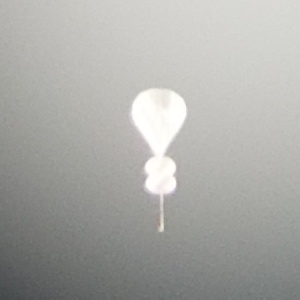
On October 22, World View launched a balloon mission from their headquarters in Tucson with callsign N137WV. I've found it making a playback of previous days activity in Flight Radar 24, since I had already seen the corresponding NOTAM published (NOTAM refers to "Notice to air men" a document filed with an aviation authority to alert aircraft pilots of potential hazards and mandatory for balloon launches and landings). After seeing the flight path I've assumed it was a zero pressure mission: the launch occured at 13:30 utc and landing was 14 hours later SSE of St.David, Arizona. However, after checking social media in the zone, I've found for my surprise several pictures of the balloon in flight showing clearly not a zero pressure balloon, but a Stratollite, similar to the one which established a record of 32 days aloft last month. It clearly made no sense to make a relatively short flight with a balloon that has demonstrated such exceptional capabilities for longer missions.
Althought World View did not publish any information on the flight, my guess is that the mission was so short due to some kind of failure with onboard systems or probably due to a leak in the balloon. Judging by the image that shows the superpressure balloons inflated and in good shape, I estimate that the possible failure could be in the upper balloon responsible for providing upward lift.
Things would change a few days later when on November 1st, World View launched another balloon from Tucson, this time with success. The balloon with callsign N136WV was launched at 12:30 utc. It ascended to 97.000 ft moving eastward and maintaining that course during the eight hours that endured the flight. The mission ended about 21:00 utc in a point located NW of Truth or Consequences in New Mexico. According to what some sources inside NASA told me, the mission was performed under the Flight Opportunities program for the benefit of the Southwest Research Institute.
-
Raven Aerostar activity
Since the last edition of this report, Raven Aerostar the veteran Sioux Falls based balloon firm performed merely four launches but nonetheless gained media attention like no other in the last days.
On October 19, they launched a balloon with callsign HBAL0347 at 14:00 utc from their Innovation Campus located a few miles from Baltic, in South Dakota. The flight endured 4 hours 30 minutes at a mean altitude of 60.000 ft, before landing at 18:50 utc SE of Monticello, Minnesota.
Five days later on October 24 was the turn of HBAL0349 which was launched also from Baltic at 14:00 utc, which spent 3 hours and 40 minutes at 65.000 ft before landing 7 km W of Jackson, Minnesota.
On October 25th, activity moved to the west with a launch performed from Mobridge Municipal Airport, a city-owned public-use airport located one nautical mile NE of downtown Mobridge, in Walworth County, close to the Missouri river. The balloon was launched at 11:10 utc and moved eastward at 65.000 ft. A curious note on this particular flight was the lack of the classic callsign shown in the ADS-B networks "HBALxxxx" which was replaced by the registration number N260TH (Raven have been assigned registration numbers for their balloons from N251TH to N260TH).
The flight developed apparently without trouble during the more than 25 hours the balloon was aloft. The tracking showed that by 12:45 utc it had landed somewhere in Saginaw county, Michigan. Below these lines you can see the flight path followed by the balloon. The landing spot was not unusual as in the last month Raven Aerostar made several flights in the area and almost two landed also in Michigan. Next day, social media started to inform that a "Space satellite crashes in front yard of Michigan home". The news sounded the alarms in my head since it is very common that the landing of both the Loon Project balloons and Raven's Thunderhead systems are confused with the fall of a satellite due to the large solar panels they carry.
Next day, social media started to inform that a "Space satellite crashes in front yard of Michigan home". The news sounded the alarms in my head since it is very common that the landing of both the Loon Project balloons and Raven's Thunderhead systems are confused with the fall of a satellite due to the large solar panels they carry.
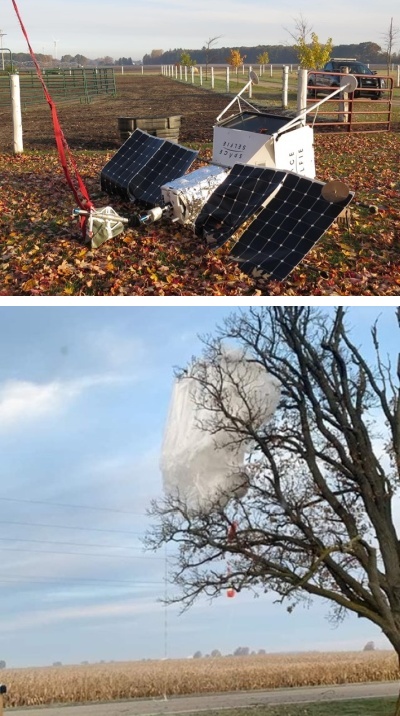
After a little search I've found the facebook page of Nancy Welke the owner of a horse farm outside Merril, Michigan who for his surprise found what we can see in the image at right.
The "space satellite" was part of a marketing campaign by Samsung known as "Space Selfie". The device was attached to a thunderhead balloon system and somewhat resembled a lunar landing module including the legs. The idea was that people could take a selfie via their own phone, then upload it throught an app to a dedicated Samsung site and then the picture would be transmitted to the balloon floating in the stratosphere. Inside the module another Galaxy S10 would receive the image and show it against a space-like background. A second onboard camera would capture the composite image and then the "space selfie" would be retransmitted back to the user.
A little after the landing of the device in Welke's property a team from Raven Aerostar arrived and recovered it without telling much about whats going on.
When the pictures went viral, Samsung published an statement saying that "...Earlier today, Samsung Europe's SpaceSelfie balloon came back down to earth. During this planned descent of the balloon to land in the US, weather conditions resulted in an early soft landing in a selected rural area. No injuries occurred and the balloon was subsequently retrieved. We regret any inconvenience this may have caused..."
What they ommited to mention was the fact that the balloon got caught up in nearby power lines as we can see in the image at right.
Besides the adverse media impact for Samsung and the localized power outages and subsequent closing of the road by county officials while removing the balloon, it was an incident with no consequences. Generally speaking, Raven Aerostar always compensate well for all damage suffered by the land owners on which -accidentally or not- they land their balloons.
However, in my humble opinion the big lesson here is for the marketing departments of big companies: always remember that the oldest aerial vehicle of men is a tricky creature. No matter what advanced technology you put hanging of them, it's an old dog too lazy to learn new tricks.
A few days after the incident of Merril, another balloon launch was performed from Baltic. HBAL0351 was sent aloft on October 31th, at 13:00 utc. After ascending to 65.000 ft it remained in flight until 20:00 utc when landed near Potsdam, Minnesota. Total flight time was 7 hours.
-
BEXUS balloon launches in Sweden
BEXUS which stands for Balloon Experiment for University Students is a project part of the REXUS/BEXUS initiative that allows students from universities and higher education colleges across Europe to carry out scientific and technological experiments on two stratospheric balloons launched each year from the ESRANGE base near Kiruna, Sweden. BEXUS is realised under a bilateral Agency Agreement between the German Aerospace Center (DLR) and the Swedish National Space Agency (SNSA). The Swedish share of the payload has been made available to students from other European countries through a collaboration with the European Space Agency (ESA)
This year, the two balloon missions carried experiments by students from the Technische Universität Dresden, the Kiel University and the University of Duisburg-Essen from Germany, the La Sapienza University of Rome from Italy, the École Polytechnique from France, the Aristotle University of Thessaloniki from Greece and the Luleå University of Technology from Sweden.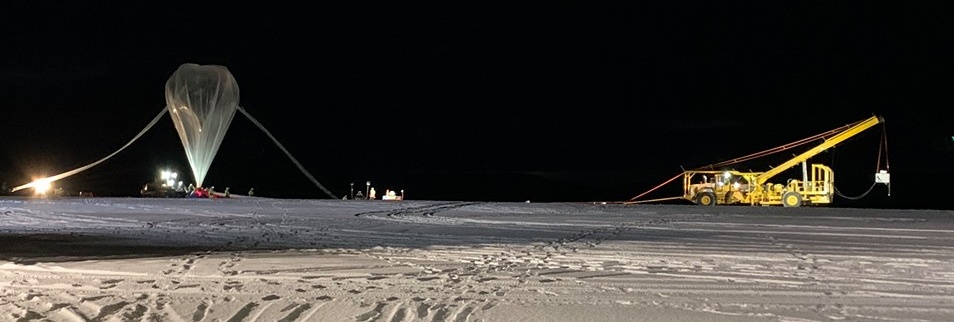 The campaign started on October 19 once all the student teams arrived to ESRANGE Space Center near Kiruna, Sweden where the launches would take place. That day after the official opening, every team started to assemble their experiments in the two balloon gondolas of the project. Full individual tests on the payloads where performed in October 21 and the Flight Compatibility Test (FCT) of BEXUS 29 was carried out on the next day.
The campaign started on October 19 once all the student teams arrived to ESRANGE Space Center near Kiruna, Sweden where the launches would take place. That day after the official opening, every team started to assemble their experiments in the two balloon gondolas of the project. Full individual tests on the payloads where performed in October 21 and the Flight Compatibility Test (FCT) of BEXUS 29 was carried out on the next day.
The first mission, BEXUS 29 was launched on October 23 at 4:33 utc. After a nominal climbing, it reached float altitude of 26 km and remained aloft 3,5 hours, before landing in Finland. That same day, BEXUS 28 completed with success the FCT. The second balloon mission was launched on October 25 at 4:21 utc following a similar path: after reaching float altitude reached of 26.7 km it moved towards Finland where it landed a few hours later. For both flights were used Airstar balloons model 35SF measuring 35.000 cubic feet of volume.
Once the recovery was completed and the payloads returned to ESRANGE, in October 27 was held the post-flight meeting during which all teams presented preliminary analysis of their in-flight results and talked about their experience through the whole campaign.
-
Strateole 2 campaign in Seychelles

In middle October, the arrival of the scientific and technical teams to Seychelles Islands in the Indian Ocean, marked the starting point of Strateole 2, a balloon launch campaign aimed to observe the equatorial higher troposphere and lower stratosphere using superpressure balloons capable of staying aloft for several months at a near-constant level. Operations will take place from the International Airport in Mahé, with the local support of Seychelles Meteorological Authority.
The initiative is a joint French-U.S. project involving numerous laboratories and institutions. The balloon division of the French space agency CNES is in charge for France of launch and tracking operations, support facilities and resources, suspended payloads, the Flight Control Centre, logistics and more broadly the management of the Strateole 2 programme and international relations.
In the french scientific side the participants are the CNRS, LMD, LATMOS, the engineering division of INSU, LPC2E, GSMA and Meteo-France, while in the american side under the aegis of the National Science Foundation are LASP Boulder, NOAA, and the Scripps Institution of Oceanography. Adittional participation include also the University of Adelaide (Australia), CNR-ISAC (Italy) and NARL (India).
During the campaign, the balloons will drift across the southern hemisphere and could overfly up to 77 countries, whose prior consent to overflights has been granted during the preparatory phase.
For this campaign has been developed a complete suite of scientific instruments to measure the atmospheric characteristics on which the mission is focused including concentrations of water vapour, ozone and carbon dioxide, detecting the presence of ice in suspension or measuring air temperature and pressure with high sensitivity. Other instruments will sound the balloon's environment, out to several kilometres using lidar or by deploying sensors underneath the balloon, or to several hundred kilometres by radio-occultation of navigation satellite signals.
In future issues of this report we will keep you informed of the ongoings of the campaign. Meanwhile, the project has a complete website with almost daily updates at https://strateole2.aeris-data.fr
-
Balloon-based test for ExoMars parachutes confirmed
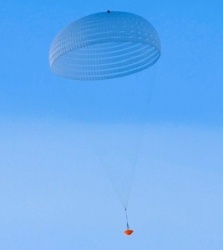
The European Space Agency confirmed recently the realization of a set of high-altitude balloon tests of the parachutes of the ExoMars 2020 rover mission during the first quarter of 2020 in Oregon. ESA officials remain confident that they will be able to resolve the parachute problems that threaten to delay the launch of the mission planned to be launched in a tight window between late July and early August of 2020.
Early this year, two balloon tests of the parachutes performed from ESRANGE in Sweden failed: first in May, and more recently in August. That made ESA to ask NASA for assistance, working with experts at the Jet Propulsion Laboratory who have experience designing parachutes for NASA's Mars landers.
Althought the tight schedule, ESA officials affirmed that they will be able to meet the launch window without any delay as the parachutes can be integrated into the descent module very late on the assembling sequence. The goal is to have the parachutes fully tested in time for a "qualification acceptance review" for the mission scheduled for late April.
Still was not revealed who will be responsible of the launch operations and besides the Oregon location, exactly which range will be used for the tests.
-
Recent publications

In early 2019, astronomers submitted 294 "APC" (Activities, Projects, and State of the Profession Considerations) white papers to the Astro2020 Decadal Survey on Astronomy and Astrophysics organized by the National Academy of Sciences. In partnership with the American Astronomical Society, these white papers are being published in the Bulletin of the AAS. Below you may find three interesting balloon related papers worth of reading.
A Roadmap For Scientific Ballooning 2020-2030 a summary of the science priorities and draft findings and recommendations of the NASA Balloon Program Analysis Group (PAG) for the purpose of informing the Astrophysics 2020 Decadal survey. PAG has been tasked by NASA to develop scientific and strategic priorities for NASA's scientific ballooning endeavors through the next decade.
The Far-Infrared Astronomy Stratospheric Balloon Facility, a recomendation to the 2020 Decadal Review Committee to build a cost-effective stratospheric balloon-borne facility observatory offering accommodation interfaces for a wide range of instruments for far-infrared astronomy. It will consist of four identical platforms featuring a 2.5-m class telescopes and will provide up to 4,000 hrs of observing time per year.
The Enabling Capabilities of the Super Pressure Balloon Platform: Diffraction-Limited, Wide-field Imaging from the Stratosphere a proposal to develope a stratospheric balloon-borne observatory whose diffraction-limited, wide-field imaging capability far exceeds that of HST. The demand for sub arc-second resolution imaging to complement the new large terrestrial programs, such as LSST, will grow exponentially in the next decade.


